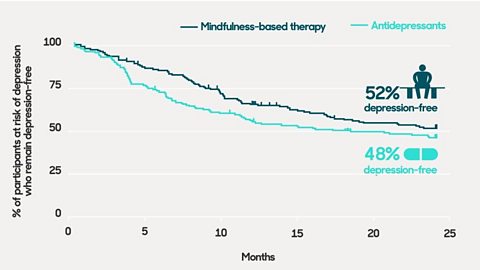The word on everyone's lips
Mindfulness seems to be everywhere – TV, radio and in every Sunday newspaper. It promises to be everything from a cure for depression to a way to improve your sex life.
Put simply, mindfulness means paying attention to the present moment. It draws on eastern meditation traditions and was introduced as a clinical therapy in the 1970s by American professor Jon Kabat-Zinn. Therapeutically, it trains people to focus their minds and understand that negative thoughts may come and go.
But does science back up the claims and is mindfulness worth a try?
Effectiveness in depression

Participants in this study had a history of depression (three or more previous episodes) and were at risk of it recurring. They were not clinically depressed at the start of the study. The lines show the proportions who remained depression-free while on treatment.
WATCH: How to do it
The clinical form of mindfulness-based therapy is led by professionals. It's usually an eight week course. But most of us can incorporate mindfulness techniques into our everyday lives. Prof Willem Kuyken suggests how you could give it a try.
People with current depression, psychosis, post-traumatic stress disorder or substance dependence should speak to a healthcare professional before trying mindfulness.
Could mindfulness really work for me?
CLAUDIA HAMMOND
So, Willem, first of all: how would you describe what mindfulness is?
WILLEM KUKYEN
Mindfulness is a capacity that we all have to bring awareness to our experience. But with particular attitudes of curiosity but also crucially of care. So for me a moment that I can really bring to full awareness is a moment where I held both my daughters for the first time. It’s very easy to me to bring to mind the full experience of seeing them, holding them, smelling them and that’s the sort of capacity that we can bring to any moment in our lives.
CLAUDIA HAMMOND
So is there a way that I can get a sense of what mindfulness feels like, right now?
WILLEM KUKYEN
One way we could do that is with some mindful eating. And one way I’d like you to do that is to take an object and to relate to this object in a way as if you’ve never encountered this object before. And we’re going to start by looking at this object form a number of different angles.
CLAUDIA HAMMOND
Yeah so it’s interesting, looking at this raisin. There’s some very shiny parts of it and then there’s kind of dark shadowy bits when you look more carefully.
OK and then we’re going to play with the sense of hearing now. Maybe just moving it between the finger and the thumb and seeing what sensations come in at the ear.
CLAUDIA HAMMOND
You don’t expect to be able to hear a raisin at all but actually if I squeeze it there’s a very tiny crinkly squeaking noise.
WILLEM KUKYEN
We’ll move to another sense now – the sense of smell. And just holding it underneath the nostril.
CLAUDIA HAMMOND
It smells very sweet but with bitterness or a sourness at the same time.
WILLEM KUKYEN
And now we’re going to pick up the sensations of taste but do this very deliberately, very slowly. Just taking the object into the mouth and moving it around with the tongue.
CLAUDIA HAMMOND
Mmm you can really feel the rough bits on it. You can feel the ridges.
WILLEM KUKYEN
And whenever you’re ready putting it between the teeth and just taking a bite into the object and very deliberately, swallowing the object.
CLAUDIA HAMMOND
Mmm that was fascinating – that’s a completely different way of eating something to the way I would normally do it. It makes it very nice but there’s also something calming about it. What else can you do to practise mindfulness in everyday life?
WILLEM KUKYEN
Two things that people have said they find helpful is the commute to work. That walk to bus stop is done with real awareness with all of the senses open to the weather and so on. Another example is the shower and instead of thinking about the day ahead or what’s just happened actually being fully present to the sensations of the water, the smell of the soap.
CLAUDIA HAMMOND
If people want to get into this further, are there specific exercises and practises they can do?
WILLEM KUKYEN
Yes there are lots of good mindfulness resources online. One is the three minute breathing space and that’s a very nice practice that sort of introduces mindfulness in three different stages.
The first stage is actually to get people to begin by just noting what’s happening for them just now in their mind, in their body, in their emotional state. And then to gather the attention on the breath so very deliberately in the second step to come in and actually focus and follow through the breath for three four five breaths . And then in the third step people are invited to expand their awareness out to the whole of their experience.
CLAUDIA HAMMOND
Sounds great might give those a try.
Learn more about this topic:
Why do Buddhists meditate? document
Have you ever wondered why people practise meditation? Bettany Hughes finds out why Buddhists meditate and learns techniques for how to meditate successfully.

My Troubled Mind - Stories about teenage mental health. collection
A powerful series of animations using personal testimony to explore mental health issues experienced by teenagers.

The Growth Mindset and Wellbeing Lesson - Live
Find out about a special BBC Teach live programme all about emotional wellbeing, aimed at primary school pupils.
